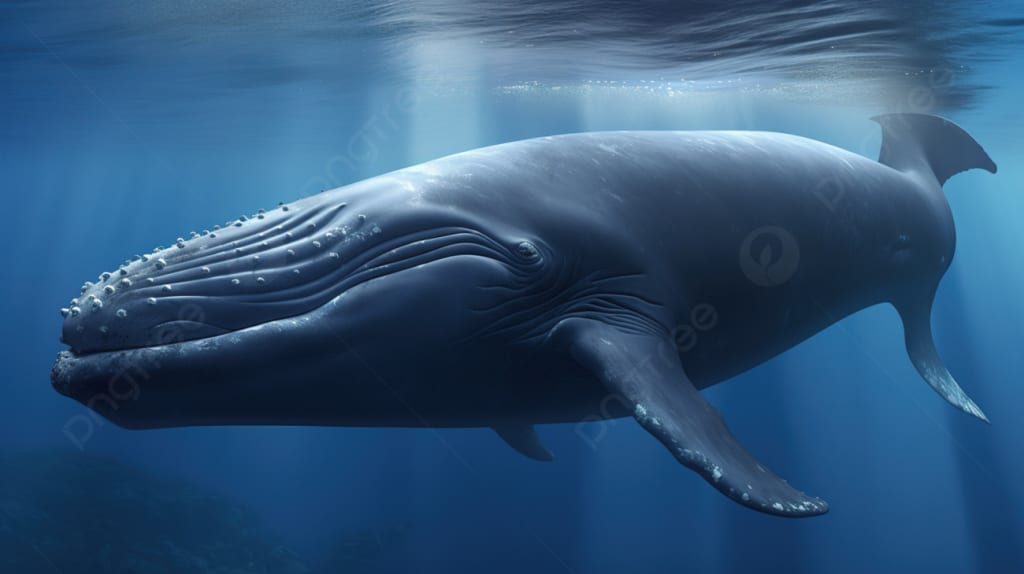The Majestic Blue Whale: Nature's Giant of the Ocean
Giant

First of all,
The largest mammal to have ever existed on Earth is the blue whale (Balaenoptera musculus). Both scientists and laypeople are in awe of it and fascinated by its immense size and presence in the ocean. This page explores the amazing traits, behavior, and state of conservation of the blue whale, providing insight into this amazing marine mammal that swims the world's waters.
Physical characteristics: Adult blue whales can grow to lengths of up to 100 feet (30 meters) and weigh up to 200 tons, making them very enormous creatures. Their sleek, streamlined bodies, which are mostly blue-gray in color but can appear brighter or darker depending on the lighting, highlight their enormous size. The speckled spots and scars on a blue whale's skin are indicative of past interactions with other whales or injuries received during migration or eating.
Feeding Habits: Blue whales are filter feeders, mostly feeding tiny shrimp-like organisms called krill, despite their enormous size. Blue whales filter enormous amounts of water by using baleen plates, which are keratin-fringed structures that dangle from the upper jaw. They do this by capturing krill in their mouths and releasing saltwater via their baleen. Blue whales eat an incredible amount of krill during feeding season, often consuming several tons in a single day, depending on where they are.
Behavior and Communication: Blue whales can communicate over hundreds of miles underwater thanks to their unique vocalizations. These low-frequency cries help whales find possible mates, communicate with one another, and maybe even find their way about their marine habitats. Even though there is still much to learn about blue whale communication, scientists are still studying the vocalizations of these animals to learn more about their social interactions and ecological responsibilities.
Migration and Habitat: Between their feeding areas and breeding grounds, blue whales migrate great distances, often thousands of miles. They can be found in every ocean on Earth, but they especially like cold, nutrient-rich waters that support healthy krill populations. While some species make lengthier migrations between breeding and feeding locations, others migrate seasonally to higher latitudes for summer grazing.
Conservation Status: Blue whales are threatened by a variety of factors, chiefly human activity, despite their size and power. Their populations have drastically declined in the past due to heavy hunting for their oil, baleen, and fat. Although international restrictions on whaling have resulted in a dramatic drop in commercial whaling, blue whales are still at risk from ship hits, entanglement in fishing gear, pollution, and habitat deterioration.
The creation of marine protected zones, laws to lessen ship strikes, and programs to lessen ocean noise pollution are some of the conservation measures meant to save blue whales. Furthermore, to ensure the long-term survival of these amazing animals and to inform conservation measures, continuous research on blue whale numbers, behavior, and ecology is necessary.
In summary, the blue whale is a representation of the size and magnificence of the world's oceans. Despite being the largest mammal on Earth and deserving of respect and adoration, human activity is posing a growing threat to its survival. We may endeavor to ensure the continued survival of blue whales and maintain the natural balance of our marine ecosystems by comprehending and solving the issues that they face.
The largest animal on Earth in terms of weight and length is the blue whale (Balaenoptera musculus). The following are some dimensions and data pertaining to blue whale size:
Length: Adult blue whales typically reach lengths of 70 to 90 feet (21 to 27 meters), which is an astounding range. Nonetheless, records of some persons' lengths exceed thirty meters, or more than one hundred feet. They are longer than even the largest dinosaurs as a result.
Weight: Adult blue whales can weigh anywhere between 100 and 200 tons (90,000 and 180,000 kg). Blue whales are exceptionally big animals. Their weight can change based on age, gender, and location, among other things.
Heart Size: A blue whale's heart is incredibly amazing. Measuring around the size of a compact vehicle and weighing about 1,300 pounds (590 kilograms), it is the largest heart of any mammal. The biggest blood vessel in the body, the aorta, is so big that a person could swim across it.
Tongue Size: Blue whales have massive tongues that can weigh up to 4,000 pounds (1,800 kg) and resemble an elephant. They feed on microscopic krill instead of larger prey because, despite their vast size, their mouths are relatively small—just around the diameter of a grapefruit.
Fins and Flippers: Blue whales normally measure about 12 inches (30 cm) tall, with very modest dorsal fins in relation to their enormous body size.
In contrast, their pectoral flippers are lengthy and thin, making up to one-third of their whole body length.
These measurements demonstrate the blue whale's amazing size and emphasize their place among the world's most amazing animals. Scientists and nature lovers alike are still in awe of them and fascinated by their majesty and size.






Comments
There are no comments for this story
Be the first to respond and start the conversation.